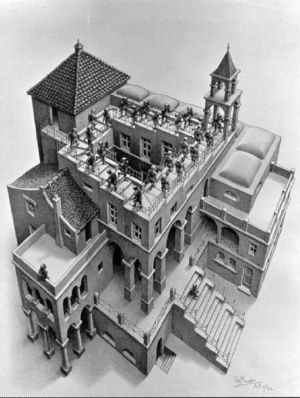Difference between revisions of "Descend"
| Line 7: | Line 7: | ||
==Description== | ==Description== | ||
| − | '''''Ascending and Descending''''' is a [[ | + | '''''Ascending and Descending''''' is a [[Prints|lithograph]] print by the Dutch artist [http://en.wikipedia.org/wiki/M. C. Escher M.C. Escher] which was first printed in March 1960. |
| − | The original print measures 14" x 11 1/4”. The lithograph depicts a large building roofed by a never-ending | + | The [[original]] [[print]] measures 14" x 11 1/4”. The lithograph depicts a large building roofed by a never-ending staircase. Two lines of identically dressed men appear on the staircase, one line ascending whilst the other descends. Two figures sit apart from the people on the [[eternal|endless]] staircase: one in a secluded courtyard, the other on a lower set of stairs. While most two-[[dimensional]] artists use [[relative]] proportions to [[create]] an [[illusion]] of depth, Escher here and elsewhere uses conflicting proportions to create the visual [[paradox]]. |
| − | ''Ascending and Descending'' was | + | ''Ascending and Descending'' was [[influence]]d by, and is an artistic implementation of, the [http://en.wikipedia.org/wiki/Lionel_Penrose Penrose stairs], an impossible object; Lionel Penrose had first published his concept in the February, 1958 issue of the ''British Journal of Psychology''. Escher developed the theme further in his [[print]] ''Waterfall'', which appeared in 1961. |
==References in popular culture== | ==References in popular culture== | ||
Revision as of 19:01, 26 December 2009
Etymology
descend
c.1300, from Old.French. descendre, from L. descendere, from de- "down" + scandere "to climb," from PIE base *skand- "jump." Sense of "originate from" is c.1375. Descent is attested from c.1330; descendant "offspring" is from 1600.
Description
Ascending and Descending is a lithograph print by the Dutch artist C. Escher M.C. Escher which was first printed in March 1960.
The original print measures 14" x 11 1/4”. The lithograph depicts a large building roofed by a never-ending staircase. Two lines of identically dressed men appear on the staircase, one line ascending whilst the other descends. Two figures sit apart from the people on the endless staircase: one in a secluded courtyard, the other on a lower set of stairs. While most two-dimensional artists use relative proportions to create an illusion of depth, Escher here and elsewhere uses conflicting proportions to create the visual paradox.
Ascending and Descending was influenced by, and is an artistic implementation of, the Penrose stairs, an impossible object; Lionel Penrose had first published his concept in the February, 1958 issue of the British Journal of Psychology. Escher developed the theme further in his print Waterfall, which appeared in 1961.
References in popular culture
- Ascending and Descending A wonderful 3D forced perspective model was build as part of a kit building contest
Sources
- Locher, J.L. (2000). The Magic of M. C. Escher. ISBN 0-8109-6720-0.
